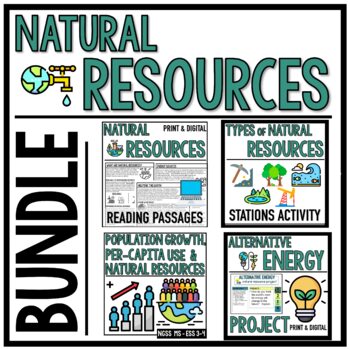Natural Resources Bundle
- Zip
What educators are saying
Products in this Bundle (5)
Bonus
Also included in
- Teaching is hard! Make things easier with this bundle that has everything you need for the full year. This year long bundle includes everything you need to teach a middle school level course that meets the NGSS 8th Grade integrated standards for California. This bundle contains a variety of engagiPrice $185.00Original Price $252.50Save $67.50
Description
This bundle focuses on natural resources and how their use affects Earth. Students start by learning the difference between nonrenewable and renewable resources and examples of each. Then students model the mining process by mining for chocolate chips and seeing how extracting resources affects the planet. The lessons continue into population growth and per capita resource use and how this affects the environment. The lesson end with a project where students research different types of energy sources and investigate the advantages and disadvantages of each.
My students love these lessons! They are hands on and apply to their lives.
See Preview for more details about each resource.
NGSS Standards
MS-ESS3-1. Construct a scientific explanation based on evidence for how the uneven distributions of Earth's mineral, energy, and groundwater resources are the result of past and current geoscience
MS-ESS3-3. Apply scientific principles to design a method for monitoring and minimizing a human impact on the environment.
MS-ESS3-4. Construct an argument supported by evidence for how increases in human population and per-capita consumption of natural resources impact Earth's systems.






